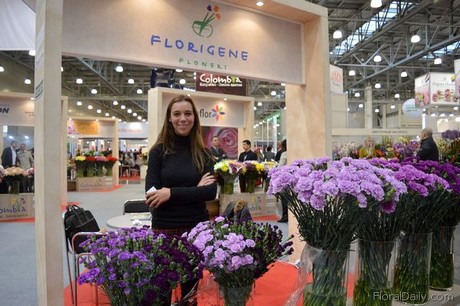
Monica Useche at the FlowersExpo in Moscow, Russia.
Gene of petunia used for color
The idea of breeding and cultivating blue carnations came from the Japanese demand for this colored flower. "There are no blue colored carnations in nature and in Japan, a blue colored flower is, culturally speaking, important. Therefore, we started to modify the carnations," says Useche. At the research and development office in Japan, the carnations are being modified. "It's the blue gene of the petunia, which gives the carnation it's blueish-purplish color," explains Useche. Currently, the assortment of Florigene Flowers consist of four large and four mini carnations. All varieties have a blueish-purplish color which range from light to dark. They are the only breeder and grower in the world who cultivates GMO carnations.
Cultivation: not different from regular carnations
The carnations are being cultivated in Colombia and Ecuador. "In Colombia we grow all varieties 100% hydroponically in a 1 ha sized greenhouse with a total size of 9 ha, 6.5 ha used for the large carnations and 2.5 used for the mini carnations. In Ecuador, only the large carnations are being cultivated in soil, also in 1 ha sized greenhouses with a total size of 6 ha,"says Useche. According to Useche, the cultivation of GMO carnations is not different to the cultivation of regular carnations. "The only difference is the color" she says, "and just like every other novelty in the ornamental sector, the GMO carnations also need to be tested before they can be used for commercial production," she continued.
Long process of allowance
According to Useche, the process of getting an approval for the carnations in a country is time-consuming. "It took us like three to four years to get an approval to export our GMO carnations to European countries," she says. Currently, only two of their large varieties are accepted in Europe. So, they are still putting effort in getting their GMO carnations allowed in Europe. Also in Australia, they are still trying to acquire an approval for all of their varieties. "In Australia, three of our large varieties are accepted." Fortunately, there are also countries where all varieties are being accepted. These countries are Russia, United States, and Japan.
New GMO Chrysanthemum
"In contrast to GMO vegetables, the reactions towards GMO flowers are very positive," says Useche. For this reason, they started to modify the color of a chrysanthemum and a rose. Currently, they are trailing blue GMO chrysanthemums and roses and at the Proflora some of these chrysanthemums will be on display. "Then we can see how the general public reacts to this new color."
For mor
 e information
e informationMonica Useche
Email: [email protected]
www.florigene.com
